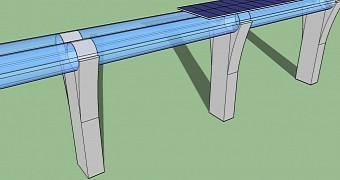There might once have been doubts about whether or not the hyperloop was a doable concept, but they are rapidly diminishing in the face of Elon Musk's stalwart enthusiasm. It's going to happen.
The Hyperloop is a conceptual high-speed transportation system that uses capsules which ride on a cushion of air (driven by a combination of linear induction motors and air compressors) through reduced-pressure tubes.
The concept was put forward by entrepreneur Elon Musk back in 2013 (there was a 57-page white paper and everything), but nothing really came of it until recently.
The founder of Tesla and SpaceX decided to go forward and establish yet another company, called Hyperloop Technologies. But he has since turned his focus to cars and rockets. Fortunately, his idea had enough time to take root in other people's brains.
The building of the first hyperloop
The hyperloop is the sort of project concept that is out there enough to work, but not sufficiently down to earth to earn funding from the government or corporations just like that.
Fortunately, Elon Musk is a rich man, and fitting with his Internet nickname of “the real Tony Stark,” is more than willing to finance the starting phase himself.
His plan, one that we mentioned some time before, is to create a test Hyperloop in Texas, or at least set aside enough space and funds for designer teams to create and test prototypes.
One of the names likely to be heard more and more in this field is that of Dirk Ahlborn, who used a crowdfunding campaign to establish a startup of his own, Hyperloop Transportation Technologies.
He and his team (who moonlight for NASA, Airbus and Boing) have already created a 76-page crowdstorming document that describes a Hyperloop system of their own.
Why Hyperloops are a massive undertaking
This is basically like building a railway track system, only with low-pressure tubes instead of rails and capsules instead of train cars.
That means they need to not only build the technology (capsule aerodynamics, seating arrangements, propulsion, safety) but also plan the optimal routes and station types. Designers also have to come up with a way to pay for it all.
Fortunately, the HTT team has proven quite willing to plot beyond the bounds of Musk's 30-minute San Francisco - Los Angeles loop (380 miles / 610 km).
All in all, it might take decades but we might actually see a Hyperloop system within our lifetime.

 14 DAY TRIAL //
14 DAY TRIAL //